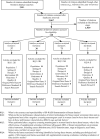Supplemental Screening for Breast Cancer in Women With Dense Breasts: A Systematic Review for the U.S. Preventive Services Task Force
- PMID: 26757021
- PMCID: PMC5100826
- DOI: 10.7326/M15-1789
Supplemental Screening for Breast Cancer in Women With Dense Breasts: A Systematic Review for the U.S. Preventive Services Task Force
Abstract
Background: Screening mammography has lower sensitivity and specificity in women with dense breasts, who experience higher breast cancer risk.
Purpose: To perform a systematic review of reproducibility of Breast Imaging Reporting and Data System (BI-RADS) density categorization and test performance and clinical outcomes of supplemental screening with breast ultrasonography, magnetic resonance imaging (MRI), and digital breast tomosynthesis (DBT) in women with dense breasts and negative mammography results.
Data sources: MEDLINE, PubMed, EMBASE, and Cochrane database from January 2000 to July 2015.
Study selection: Studies reporting BI-RADS density reproducibility or supplemental screening results for women with dense breasts.
Data extraction: Quality assessment and abstraction of 24 studies from 7 countries; 6 studies were good-quality.
Data synthesis: Three good-quality studies reported reproducibility of BI-RADS density; 13% to 19% of women were recategorized between "dense" and "nondense" at subsequent screening. Two good-quality studies reported that sensitivity of ultrasonography for women with negative mammography results ranged from 80% to 83%; specificity, from 86% to 94%; and positive predictive value (PPV), from 3% to 8%. The sensitivity of MRI ranged from 75% to 100%; specificity, from 78% to 94%; and PPV, from 3% to 33% (3 studies). Rates of additional cancer detection with ultrasonography were 4.4 per 1000 examinations (89% to 93% invasive); recall rates were 14%. Use of MRI detected 3.5 to 28.6 additional cancer cases per 1000 examinations (34% to 86% invasive); recall rates were 12% to 24%. Rates of cancer detection with DBT increased by 1.4 to 2.5 per 1000 examinations compared with mammography alone (3 studies). Recall rates ranged from 7% to 11%, compared with 7% to 17% with mammography alone. No studies examined breast cancer outcomes.
Limitations: Good-quality evidence was sparse. Studies were small and CIs were wide. Definitions of recall were absent or inconsistent.
Conclusion: Density ratings may be recategorized on serial screening mammography. Supplemental screening of women with dense breasts finds additional breast cancer but increases false-positive results. Use of DBT may reduce recall rates. Effects of supplemental screening on breast cancer outcomes remain unclear.
Primary funding source: Agency for Healthcare Research and Quality.
Conflict of interest statement
Potential Conflicts of Interest: Disclosures can be viewed at XXX
Figures





Comment in
-
Supplemental Breast Cancer Screening in Women With Dense Breasts Should Be Offered With Simultaneous Collection of Outcomes Data.Ann Intern Med. 2016 Feb 16;164(4):299-300. doi: 10.7326/M15-2977. Epub 2016 Jan 12. Ann Intern Med. 2016. PMID: 26757338 Free PMC article. No abstract available.
Similar articles
-
Supplemental Screening as an Adjunct to Mammography for Breast Cancer Screening in People With Dense Breasts: A Health Technology Assessment.Ont Health Technol Assess Ser. 2023 Dec 19;23(9):1-293. eCollection 2023. Ont Health Technol Assess Ser. 2023. PMID: 39364436 Free PMC article.
-
Supplemental Screening for Breast Cancer in Women With Dense Breasts: A Systematic Review for the U.S. Preventive Service Task Force [Internet].Rockville (MD): Agency for Healthcare Research and Quality (US); 2016 Jan. Report No.: 14-05201-EF-3. Rockville (MD): Agency for Healthcare Research and Quality (US); 2016 Jan. Report No.: 14-05201-EF-3. PMID: 26866210 Free Books & Documents. Review.
-
Harms of Breast Cancer Screening: Systematic Review to Update the 2009 U.S. Preventive Services Task Force Recommendation.Ann Intern Med. 2016 Feb 16;164(4):256-67. doi: 10.7326/M15-0970. Epub 2016 Jan 12. Ann Intern Med. 2016. PMID: 26756737 Review.
-
Digital Breast Tomosynthesis with Hologic 3D Mammography Selenia Dimensions System for Use in Breast Cancer Screening: A Single Technology Assessment [Internet].Oslo, Norway: Knowledge Centre for the Health Services at The Norwegian Institute of Public Health (NIPH); 2017 Sep 4. Report from the Norwegian Institute of Public Health No. 2017-08. Oslo, Norway: Knowledge Centre for the Health Services at The Norwegian Institute of Public Health (NIPH); 2017 Sep 4. Report from the Norwegian Institute of Public Health No. 2017-08. PMID: 29553669 Free Books & Documents. Review.
-
Screening Performance of Digital Breast Tomosynthesis vs Digital Mammography in Community Practice by Patient Age, Screening Round, and Breast Density.JAMA Netw Open. 2020 Jul 1;3(7):e2011792. doi: 10.1001/jamanetworkopen.2020.11792. JAMA Netw Open. 2020. PMID: 32721031 Free PMC article.
Cited by
-
Assessment of the Breast Density Prevalence in Swiss Women with a Deep Convolutional Neural Network: A Cross-Sectional Study.Diagnostics (Basel). 2024 Oct 3;14(19):2212. doi: 10.3390/diagnostics14192212. Diagnostics (Basel). 2024. PMID: 39410616 Free PMC article.
-
Clinical guidelines for the management of mammographic density: a systematic review of breast screening guidelines worldwide.JNCI Cancer Spectr. 2024 Nov 1;8(6):pkae103. doi: 10.1093/jncics/pkae103. JNCI Cancer Spectr. 2024. PMID: 39392432 Free PMC article.
-
Obesity-driven changes in breast tissue exhibit a pro-angiogenic extracellular matrix signature.Matrix Biol Plus. 2024 Sep 22;24:100162. doi: 10.1016/j.mbplus.2024.100162. eCollection 2024 Dec. Matrix Biol Plus. 2024. PMID: 39380725 Free PMC article.
-
Supplemental Screening as an Adjunct to Mammography for Breast Cancer Screening in People With Dense Breasts: A Health Technology Assessment.Ont Health Technol Assess Ser. 2023 Dec 19;23(9):1-293. eCollection 2023. Ont Health Technol Assess Ser. 2023. PMID: 39364436 Free PMC article.
-
Risk Factors and Mortality Among Women With Interval Breast Cancer vs Screen-Detected Breast Cancer.JAMA Netw Open. 2024 May 1;7(5):e2411927. doi: 10.1001/jamanetworkopen.2024.11927. JAMA Netw Open. 2024. PMID: 38767918 Free PMC article.
References
-
- Carmona-Sanchez E, Cuadros Lopez JL, Cuadros Celorrio AM, Perez-Roncero G, Gonzalez Ramirez AR, Fernandez Alonso AM. Assessment of mammographic density in postmenopausal women during long term hormone replacement therapy. Gynecol Endocrinol. 2013;29(12):1067–70. - PubMed
-
- Del Carmen MG, Hughes KS, Halpern E, Rafferty E, Kopans D, Parisky YR, et al. Racial differences in mammographic breast density. Cancer. 2003;98(3):590–6. - PubMed
-
- Centers for Disease Control and Prevention. Breast Cancer Rates by Race and Ethnicity 2014 [March 3, 2015] Available from: http://www.cdc.gov/cancer/breast/statistics/race.htm.
Publication types
MeSH terms
Grants and funding
LinkOut - more resources
Full Text Sources
Other Literature Sources
Medical

